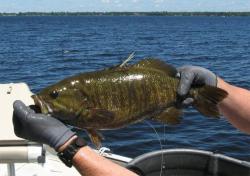After Lake Champlain Fish Tournaments: Study Finds Where the Fish Go
from The Fishing Wire
Today’s feature, an interesting study on where bass go after being released at weigh-ins, comes to us from Lake Champlain International; www.mychamplain.net.
By Daniel Kelly
The Lake Champlain bass dispersal project crew (Credit: Lake Champlain Research Institute, SUNY Plattsburgh)Lake Champlain has been a popular bass fishing spot for some time, made so by its size, surrounding scenery and abundant fish habitat, especially in its northern end. The lake’s expansive tributaries also draw in anglers who like to rev up their fishing boats and make waves.
But with prized bass there getting more and more attention, scientists with the Lake Champlain Sea Grant wanted to know what impacts all the activity was having on the fishery.
“There are probably 75 tournaments on this lake each year,” said Mark Malchoff, aquatic resources specialist with the Sea Grant. “And about four to six of them are big ones with sometimes 100 boats.”
Malchoff, along with investigators from the Lake Champlain Research Institute at the State University of New York – Plattsburgh, wanted to quantify the impacts of catch-and-release policies at the competitions and how bass disperse after they’ve been released back into the water.
Their study began with tagging fish. Some were fitted with radio transmitters, but a vast majority were tagged with T-bars: tiny tags inserted between spines in dorsal fins. All of those had Malchoff’s phone number and email address on them.
“You sort of release them and hope someone finds one, but there’s no guarantee,” said Malchoff. “It’s a classic letter in a bottle.”
Surgery underway on a Lake Champlain bass (Credit: D. Garneau, SUNY Plattsburgh)The approach was useful because two tag methods allowed researchers to find if one was more reliable for tracking and if there were any effects caused by the tags themselves. Malchoff says there was good agreement between the two, with both helping researchers track bass movement through Lake Champlain during and after tournaments.
Largemouth bass, researchers found, are especially affected during tournament time. They experience more stress than smallmouth, as judged by a series of indicators including bloody fins, hook wounds or fin damage. A lot of the stress comes from being housed in livewells, which takes its toll. They may also be targeted more as competition labors on.
“With tournaments – the big ones at least – by day three, only the Top 10 to 20 anglers are still fishing,” said Malchoff. “At that point, they’re targeting the biggest fish they can find.” And with live fish valued more at weigh-in time, fishermen try to keep fish swimming. “But the farther you move them (in livewells), the more likely it is they’ll get beat up,” said Malchoff.
A post-op tagged smallmouth (Credit: Lake Champlain Research Institute, SUNY Plattsburgh)
Smallmouth bass also exhibited signs of stress, but not as much as largemouths. Both bass types appeared more prone to bloody fins as water temperatures increased. And after they had been released back into Lake Champlain, researchers found that bass swam toward the north side. There is plenty of high-quality habitat on that end, says Malchoff, and going north saves a trip over deep-water areas to reach the southern end.
All the findings boil down to a few things fishermen and tournament organizers can do to protect and conserve bass in Champlain. “Don’t transport them as far (in livewells), and lake temperature – in a lot of places, waters are warmest in late July or early August – avoid scheduling tournaments at those times if at all possible,” said Malchoff.
Researchers also provided evidence against a commonly held notion that many types of fish stress could be attributed to barotrauma, or damage caused to them by sudden pressure changes. Fish that don’t maintain equilibrium don’t always need to have their air bladders deflated, Malchoff says, something that tournament anglers often do.
“My real interest is looking at tournaments as a sustainable resource,” said Malchoff. “And like a lot of things, there’s always room for improvement.”


